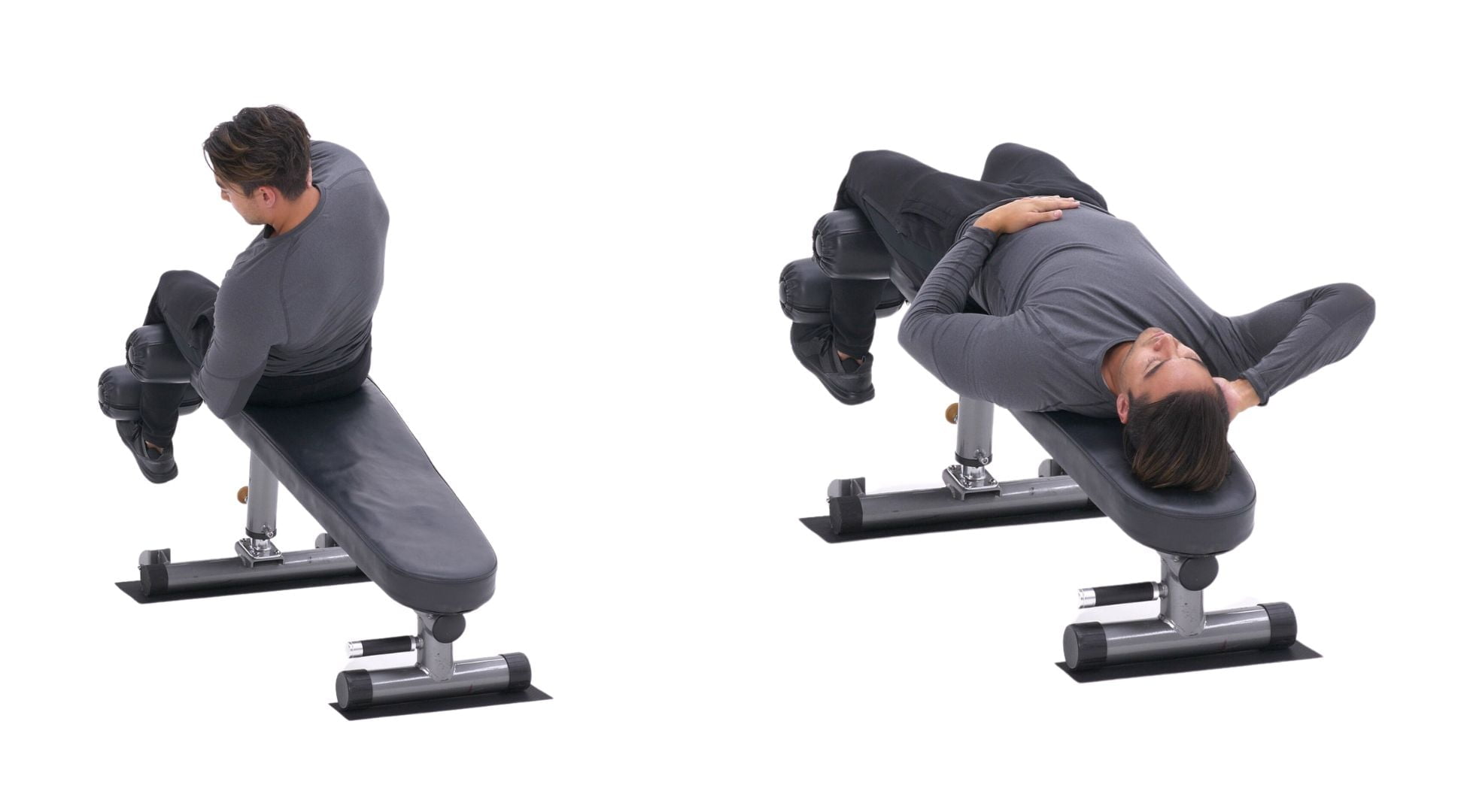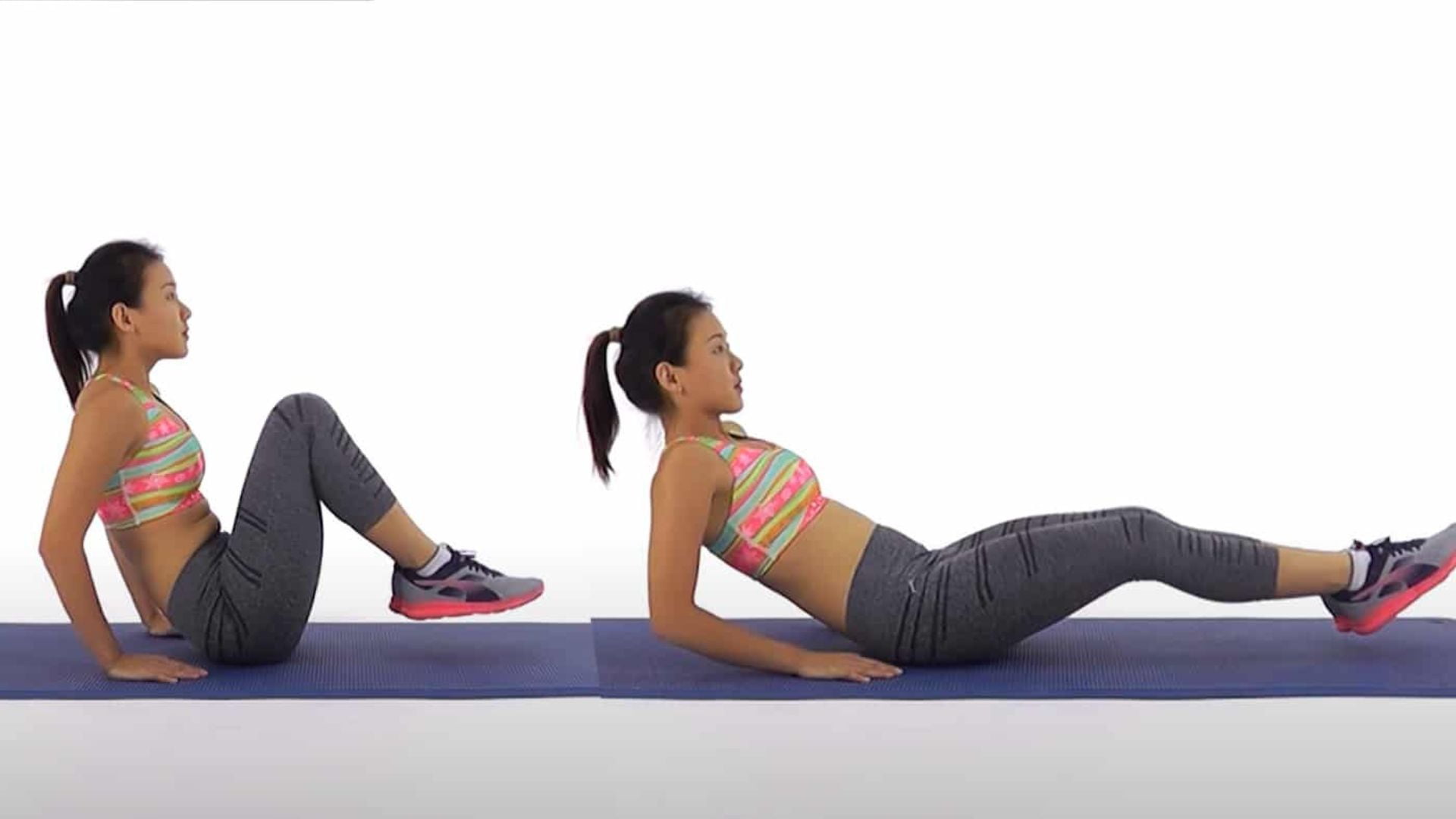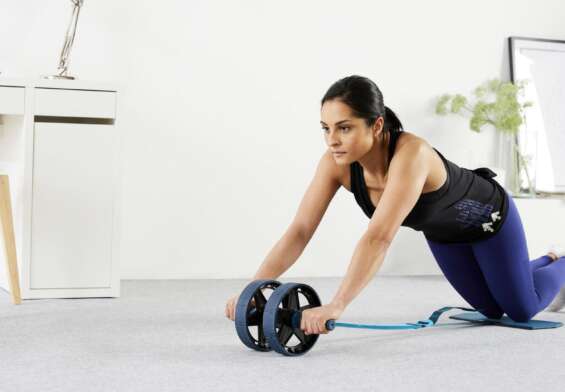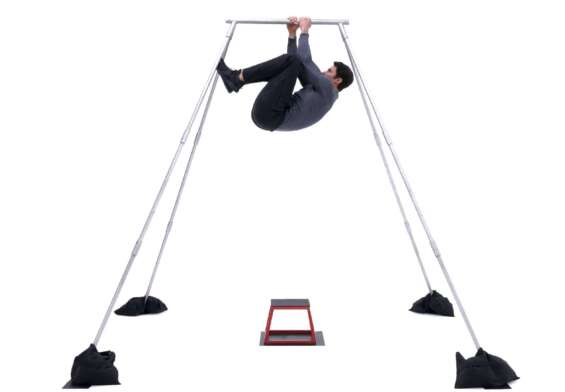
Decline Oblique Crunch (Strengthen Abs and Obliques) Technique Tips
Are you looking for a challenging exercise that can help you burn calories and improve your overall fitness level? Look no further than Decline Oblique Crunch! This full-body exercise is designed to target multiple muscle groups, including your lower abdomen, obliques, and hips, making it an excellent addition to any workout routine. Here at FitGAG, we’ve put together our expert guide to help you master Decline Oblique Crunch and achieve your fitness goals.
Exercise Information
The Decline Oblique Crunch is a resistance training exercise that targets the muscles in the abdominal region. This exercise involves using a decline bench to add resistance throughout the entire range of motion, increasing muscle activation in the targeted muscle groups. Let’s dive into some general information about this exercise:
Level
The Decline Oblique Crunch is a beginner-level exercise that is suitable for individuals of all fitness levels.
Equipment
To perform the Decline Oblique Crunch, you will need a decline bench.
Type of Exercise
The Decline Oblique Crunch is an isolation exercise that targets the muscles in the abdominal region, involving a single-joint movement that mainly focuses on one specific muscle group.
Decline Oblique Crunch: Working Muscles
The Decline Oblique Crunch is an isolation exercise that primarily targets the abdominal muscles. This exercise involves using a decline bench to add resistance to the traditional crunch motion. In this section, we will discuss the primary and secondary muscle groups that are involved during the Decline Oblique Crunch exercise.
Primary Muscle Group: Abdominals
The primary muscle group targeted during the Decline Oblique Crunch exercise is the abdominals, including the rectus abdominis, internal and external obliques, and transverse abdominis. These muscles are responsible for flexing the trunk, which is the primary motion of the Decline Oblique Crunch exercise.
Secondary Muscle Group: Hips
In addition to the primary muscle group, the Decline Oblique Crunch exercise also engages the muscles of the hips. The hip flexors and gluteus muscles are engaged during the crunching motion to stabilize the joint and maintain proper posture.
By engaging both the primary and secondary muscle groups, the Decline Oblique Crunch exercise provides a comprehensive core workout. This makes it an effective exercise for building abdominal and hip muscle strength and size, improving posture and stability, and developing functional fitness for activities in daily life.
Stay tuned for the next section, where we will discuss the benefits of the Decline Oblique Crunch exercise.
Benefits of Decline Oblique Crunch
Decline Oblique Crunch is an exercise that targets your core muscles and offers several benefits. Here are five benefits of incorporating this exercise into your fitness routine:
- Improved Balance and Stability: Decline Oblique Crunch helps improve your balance and stability by strengthening your core muscles and improving your overall body alignment.
- Enhanced Muscle Recruitment: Decline Oblique Crunch engages more muscles in your core, which can help improve overall functional strength and movement patterns.
- Increased Range of Motion: Decline Oblique Crunch allows you to work your core through a full range of motion, which can help improve your overall core flexibility.
- Reduced Risk of Injury: Decline Oblique Crunch can help improve your overall joint stability and reduce the risk of injury and strain on your core muscles.
- Variation and Progression: Decline Oblique Crunch can add variation to your core workouts, which can help prevent boredom and stimulate new muscle growth. Additionally, the exercise can be made more challenging by using heavier weights or increasing the number of reps.
By incorporating Decline Oblique Crunch into your fitness routine, you can enjoy these benefits and more. However, it’s important to start slowly and progress gradually to avoid injury and ensure proper form. Additionally, it’s important to incorporate a variety of exercises into your fitness routine to ensure you’re targeting all muscle groups and avoiding boredom.
Decline Oblique Crunch: Step-by-Step Instructions
The decline oblique crunch is an exercise that targets your obliques and other core muscles. Here are the step-by-step instructions for performing the decline oblique crunch:
Starting Position:
- Lie on a decline bench with your feet securely fastened.
- Place your hands behind your head.
- Position your feet at the end of the decline bench so that your body is propped up at an angle.
Now, let’s move on to the step-by-step instructions for the decline oblique crunch:
- Begin by keeping your back and neck flat on the bench as you lift your shoulders off the bench.
- Rotate your torso to the left, bringing your right elbow towards your left knee.
- Pause briefly at the end of the movement.
- Slowly return to the starting position.
Repeat the movement for the desired number of repetitions, then switch sides.
Decline Oblique Crunch – Proper Form and Technique
The Decline Oblique Crunch is an effective exercise that targets the obliques and core muscles. This exercise is performed using a decline bench, and proper form and technique are important to avoid injury and achieve maximum results.
Starting Position
- Lie on the decline bench with your feet secured, and a medicine ball or weight plate held in your hands.
- Hold the ball or plate with both hands, with your arms extended straight up in the air.
- Engage your core muscles and maintain a stable base.
Proper Form and Technique
- Bring the Ball to Your Opposite Knee: Keeping your arms straight, bring the ball or plate to your opposite knee.
- Keep Your Arms Straight: Keep your arms straight and your elbows slightly bent throughout the exercise, using your core muscles to control the movement.
- Return to the Starting Position: Return to the starting position by bringing the ball or plate back up to the starting position.
- Breathe Deeply: Breathe deeply and regularly throughout the exercise to maintain your energy and focus.
- Gradually Increase Intensity: Gradually increase the number of repetitions or sets of the exercise over time as your core muscles become stronger.
- Incorporate into Your Routine: The Decline Oblique Crunch can be a great addition to your core training routine, helping you to build strength and muscle effectively.
By following these tips, you can perform the Decline Oblique Crunch with proper form and technique, building and strengthening your obliques and core muscles effectively while minimizing the risk of injury. Remember to start slowly, focus on your breathing, and gradually increase the difficulty and intensity of the exercise over time.
Frequency and Progression: How to Get the Most Out of Your Decline Oblique Crunch Workouts
The Decline Oblique Crunch is an abdominal exercise that targets the oblique muscles on the sides of the abdomen. In this section, we will discuss how to properly incorporate the Decline Oblique Crunch into your workout routine and how to progress with this exercise over time.
Frequency
To see significant results with the Decline Oblique Crunch, it is recommended to perform this exercise 2-3 times a week. However, it is important to listen to your body and avoid overtraining. If you feel any pain or discomfort, stop the exercise immediately. You can also alternate between the Decline Oblique Crunch and other abdominal exercises, such as bicycle crunches or planks.
Progressive Overload
To progress with the Decline Oblique Crunch, it is important to gradually increase the difficulty of the exercise over time. Start with a lighter weight and gradually increase the weight as you become stronger. Another way to progress is to decrease the rest time between sets or increase the number of repetitions. Gradually increase the resistance and reps/sets and avoid adding too much too quickly.
Mix It Up
To prevent boredom and keep your Decline Oblique Crunch workouts fresh, it is important to mix up your exercise routine. You can perform the Decline Oblique Crunch with different weights or vary the number of reps and sets. You can also incorporate other abdominal exercises, such as Russian Twists or Leg Raises.
Proper Form
Proper form is essential when performing the Decline Oblique Crunch to avoid injury and get the most out of the exercise. Start by lying on your back on a decline bench and holding a weight in each hand. Keep your feet flat on the bench, your back flat against the bench, and your head in line with your spine. Bend your knees and lift your feet off the bench. Contract your obliques to bring your knees and elbows together in a crunching motion. Return to the starting position and repeat. Keep your core engaged and your back flat throughout the movement.
Track Your Progress
To ensure you are making progress and staying on track with your Decline Oblique Crunch workouts, it is important to track your progress. Keep a workout journal or use a fitness app to log the weights, reps, and sets for each exercise. This will help you identify areas where you need to improve and keep you motivated to continue pushing yourself.
Incorporating the Decline Oblique Crunch into your abdominal workout routine can be a great way to build strength and improve your core stability. By following these tips for frequency, progressive overload, and proper form, you can ensure that you are getting the most out of your Decline Oblique Crunch workouts and reaching your fitness goals.
Mistakes of Decline Oblique Crunch Exercise
The decline oblique crunch exercise is a great way to target your obliques and improve your core strength. However, like any exercise, there are common mistakes that can reduce its effectiveness and increase the risk of injury. Here are five mistakes to avoid during the decline oblique crunch exercise:
- Not using proper form: Using poor form during the decline oblique crunch exercise can reduce its effectiveness and increase the risk of injury. It’s essential to maintain proper alignment of your hips, shoulders, and head throughout the exercise.
- Using too much resistance: Using too much resistance during the decline oblique crunch exercise can increase the risk of injury and reduce its effectiveness. Instead, focus on using a weight that allows you to maintain proper form.
- Not using a full range of motion: Neglecting to use a full range of motion during the decline oblique crunch exercise can reduce its effectiveness. Make sure to fully extend your arms in front of your body before returning to the starting position.
- Not engaging the oblique muscles: Engaging the oblique muscles is essential to ensure that you are targeting the correct muscles during the decline oblique crunch exercise. Failure to engage these muscles can reduce the effectiveness of the exercise.
- Not using proper breathing: Using improper breathing technique during the decline oblique crunch exercise can reduce its effectiveness and increase the risk of injury. Make sure to exhale as you crunch and inhale as you return to the starting position.
By avoiding these common mistakes, you can ensure that you are getting the most out of your decline oblique crunch exercise while reducing the risk of injury. Remember to use proper form, use an appropriate resistance, use a full range of motion, engage the oblique muscles, and use proper breathing throughout the exercise. With consistent practice, you can improve your core strength with the decline oblique crunch exercise.
Variations of Decline Oblique Crunch: Add Challenge to Your Core Training
Decline Oblique Crunch is a great exercise to help target and strengthen your core muscles. However, doing the same exercise every day can become monotonous over time. Here are some variations to add challenge and variety to your training routine and challenge your core muscles in different ways:
Decline Oblique Crunch with Resistance Bands
This variation involves using heavier resistance bands to add extra resistance and challenge your core muscles. Be sure to use proper form and technique and avoid jerking or pulling the bands.
Decline Oblique Crunch with Pause
This variation involves pausing for a few seconds at the end of each repetition, which challenges your core muscles and improves your overall muscular endurance. Be sure to keep your core engaged and your feet firmly planted on the floor throughout the exercise.
Decline Oblique Crunch with Isometric Hold
This variation involves holding the fully contracted position of the exercise for a few seconds, which challenges your core muscles and improves your overall muscular endurance. Be sure to keep your core engaged and your feet firmly planted on the floor throughout the exercise.
Decline Oblique Crunch with Weight Plate
This variation involves adding a weight plate to the exercise, which adds extra resistance and challenges your core muscles. Be sure to use proper form and technique and avoid jerking or pulling the weight plate.
Incorporating these variations into your Decline Oblique Crunch routine can help you add challenge and variety to your core training and achieve greater gains in overall core strength and fitness. As always, make sure to use proper form and technique to avoid injury.
Decline Oblique Crunch: 5 Alternatives to Strengthen Your Core
The decline oblique crunch is a great exercise for strengthening your core and improving your posture. However, if you’re looking to mix up your routine or add some variety, there are plenty of alternatives you can try. In this section, we’ll explore five exercises that target your core and can help you build strength and improve your posture.
Crunches
Crunches are a great exercise for targeting your core and improving your posture.
- Lie down on your back with your legs bent and your feet flat on the floor.
- Cross your arms across your chest and lift your shoulders off the floor.
- Lower your shoulders back down and repeat for the desired number of repetitions.
Plank
The plank is a great exercise for targeting your core and building strength.
- Start in a push-up position, but rest your weight on your forearms instead of your hands.
- Keep your body in a straight line from your head to your feet.
- Hold this position for the desired amount of time before returning to the starting position.
Side Plank
Side plank is a great exercise for targeting your core and building strength.
- Lie on one side with your elbow directly underneath your shoulder.
- Lift your hips off the floor and keep your body in a straight line.
- Hold this position for the desired amount of time before returning to the starting position.
Russian Twist
Russian twists are a great exercise for targeting your core and improving your posture.
- Sit on the floor with your knees bent and your feet flat on the floor.
- Hold a medicine ball with both hands and twist your torso from side to side.
- Keep your feet on the ground and twist as far as you can without lifting them off the floor.
Bicycle Crunches
Bicycle crunches are a great exercise for targeting your core and improving your posture.
- Lie on your back with your legs bent and your feet flat on the floor.
- Lift your legs off the floor and bring one knee towards your chest while extending the other leg.
- Switch legs and repeat for the desired number of repetitions.
Incorporating these alternatives to decline oblique crunch exercises into your routine is a great way to strengthen your core and improve your posture. These exercises require little to no equipment and can be done at home or at the gym. Give them a try and see how they work for you!
Decline Oblique Crunch: Tips and Tricks for Building Stronger Core and Oblique Muscles
The Decline Oblique Crunch is a great exercise for targeting your core and oblique muscles. In this section, we’ll share some tips and tricks to help you perform the Decline Oblique Crunch correctly and get the most out of it.
- Warm-Up: Before performing the Decline Oblique Crunch, it’s important to warm up your entire core. You can do this by performing some light cardio or dynamic stretching, such as torso rotations.
- Use the Right Equipment: To perform the Decline Oblique Crunch, you need a decline bench. Make sure you choose the right decline angle for your needs and follow the manufacturer’s instructions for use.
- Proper Form: Maintaining proper form is crucial when performing the Decline Oblique Crunch. Begin by lying on the decline bench with your feet firmly planted on the floor. Keeping your arms straight, crunch up to the side until your shoulders are off the bench, then slowly return to the starting position.
- Engage Your Core and Obliques: To perform the Decline Oblique Crunch correctly, you need to engage your core and oblique muscles. Focus on squeezing your oblique muscles as you crunch up to the side.
- Use the Right Repetition Range: Aim to perform 2-3 sets of 8-12 reps with the Decline Oblique Crunch.
- Mix it Up: Mixing up your Decline Oblique Crunch routine can help keep your workout fresh and challenging. You can try different variations, such as changing the decline angle or adding a weight plate.
- Stretch Afterwards: After performing the Decline Oblique Crunch, it’s important to stretch your entire core, especially your obliques.
- Listen to Your Body: As with any exercise, it’s important to listen to your body and avoid pushing beyond your limits. If you feel any discomfort or pain, stop the exercise immediately.
Incorporating these tips and tricks into your Decline Oblique Crunch routine can help you get the most out of this exercise and achieve stronger core and oblique muscles. Remember to always maintain proper form, engage your core and oblique muscles, and listen to your body. With time and practice, you’ll be able to perform the Decline Oblique Crunch like a pro and enjoy the benefits of stronger and more toned core and obliques.
Incorporating Decline Oblique Crunches into Your Workout Routine for Maximum Effect
Decline oblique crunches are a great exercise for strengthening your core and improving your posture. Here are some tips to help you incorporate this exercise into your workout routine for maximum effect:
- Warm-up properly: Before doing decline oblique crunches, it’s important to warm up your core with exercises like planks, leg lifts, and side bends.
- Use proper form: To perform decline oblique crunches, lie on a decline bench with your legs securely strapped in. Place your hands behind your head and lift your torso up, crunching to one side. Make sure to keep your lower back flat against the bench and don’t pull on your neck. Return to the starting position and repeat on the other side.
- Mix up your routine: Don’t just perform decline oblique crunches in isolation. Mix it up by incorporating other exercises that target your core, such as reverse crunches, bicycle crunches, and standing side bends.
- Use progressive overload: To continue to see progress, you’ll need to use progressive overload, which means gradually increasing the resistance or repetitions over time.
- Don’t overdo it: It’s important to give your muscles time to recover, so don’t overdo it with decline oblique crunches. Aim to perform the exercise for 2-3 sets, 1-2 times per week.
- Focus on your breathing: It’s important to regulate your breathing throughout the exercise to ensure that you’re getting enough oxygen to your muscles. Inhale as you crunch to one side and exhale as you return to the starting position.
- Engage your core: To get the most out of decline oblique crunches, make sure to engage your core muscles, including your abs and lower back. This will help you maintain proper form and prevent injury.
- Rest between sets: Allow your muscles time to recover between sets. Rest for 60-90 seconds between sets to ensure that you’re performing each rep with proper form.
- Incorporate decline oblique crunches into your workout routine: In addition to incorporating decline oblique crunches into your workout routine, consider doing them as part of a superset or a circuit to challenge your muscles even more.
By incorporating these tips into your workout routine, you’ll be well on your way to maximizing the benefits of decline oblique crunches and achieving a stronger core and better posture.
Ultimate Workout Plan for Decline Oblique Crunch
Decline Oblique Crunch is an effective exercise for strengthening your abdominal muscles and improving your core stability. Here’s a one-week workout plan to help you incorporate Decline Oblique Crunch into your routine:
Day 1: Warm-up
- Warm-up: 5-10 minutes of cardio
- Decline Oblique Crunch: 3 sets x 12-15 reps
- Crunches: 3 sets x 10 reps
- Sit-ups: 3 sets x 10 reps
- Lying Leg Raises: 3 sets x 12 reps
- Cool-down: 5-10 minutes of stretching
Day 2: Rest Day
Day 3: Lower Body
- Warm-up: 5-10 minutes of cardio
- Decline Oblique Crunch: 3 sets x 12-15 reps
- Squats: 3 sets x 10 reps
- Lunges: 3 sets x 10 reps
- Glute Bridges: 3 sets x 12 reps
- Cool-down: 5-10 minutes of stretching
Day 4: Rest Day
Day 5: Full Body
- Warm-up: 5-10 minutes of cardio
- Decline Oblique Crunch: 3 sets x 12-15 reps
- Push-ups: 3 sets x 12 reps
- Burpees: 3 sets x 10 reps
- Mountain Climbers: 3 sets x 15 reps
- Cool-down: 5-10 minutes of stretching
Day 6: Rest Day
Day 7: Lower Body
- Warm-up: 5-10 minutes of cardio
- Decline Oblique Crunch: 3 sets x 12-15 reps
- Deadlifts: 3 sets x 10 reps
- Step-ups: 3 sets x 10 reps
- Calf Raises: 3 sets x 12 reps
- Cool-down: 5-10 minutes of stretching
Remember to maintain proper form and technique when performing Decline Oblique Crunch. Keep your movements slow and controlled, and focus on engaging your abdominal muscles throughout the exercise. With consistent practice and effort, you’ll be able to build a stronger and more stable core with Decline Oblique Crunch.
Conclusion
Decline Oblique Crunch is a great exercise for anyone looking to tone their obliques and strengthen their core muscles. However, it’s important to use proper form and start with lighter resistance before gradually increasing the intensity to avoid injury and get the most out of the exercise. Remember to keep your movements slow and controlled throughout the exercise, and engage your oblique muscles for maximum contraction. So, if you’re ready to take your core workout to the next level and tone your obliques, give Decline Oblique Crunch a try with our expert guide. Thanks for reading, and keep fit with FitGAG!











